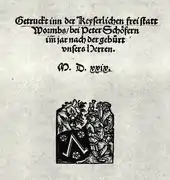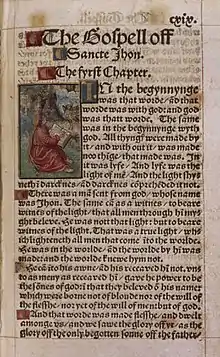Peter Schöffer the Younger
Peter Schöffer the Younger (c. 1480–1547) was a German printer, the son of Peter Schöffer, a former apprentice of Johannes Gutenberg. He printed the Tyndale Bible, the first mass produced English edition of the New Testament, and the first complete German Protestant translation of the bible. Schöffer also cast type for musical notation and printed music.

Family background and early life

Schöffer was born in Mainz between 1475 and 1480, into a family involved in the early printing business.[1][2] His father was Peter Schöffer (c. 1425–1503), who had been an apprentice with Johannes Gutenberg. His mother was Christina Fust, the only daughter of Johann Fust, who had lent money to Gutenberg and taken over his print shop after Gutenberg defaulted on his loans.[3] Schöffer learned the trades of punchcutter and type caster.[4][5] He became very skilled in this; his types were later also used in his brother's workshop and traded also to other cities.[5] He married Katharina, of unknown last name, and they had a son, Ivo (c. 1500–1555), who also became a printer.[2] After his father's death c. 1503, the print workshop was taken over by his brother Johann Schöffer.[6] Peter Schöffer the Younger inherited the "zum Korb" house in Mainz and set up his workshop there c. 1509.[7][8] The first book printed by Schöffer was Responsoria Moguntina c. 1510, but his specialty was the printing of music.[8] He cast type for mensural notation and imitated and reprinted work of Ottaviano Petrucci. His first printed work with musical notation was a tablature book for organ and lute.[9] In 1512, he sold the house and moved to Worms, where he came in contact with the anabaptists.[10]
Printer in Worms

While in Worms, Schöffer printed the first New Testament in English in 1526, the Tyndale Bible, translated from the Greek by William Tyndale.[11][12] Unlike Tyndall's earlier fragment printed in Cologne, it is a complete New Testament. To smuggle copies to England, the books were hidden in bales of cloth and transported in ships along the Rhine.[11] Although the book was printed in an edition of 6000 octavo copies,[13] only three of them have survived, and just one of these contains the title page, the copy found in 1996 in an old bible collection in Stuttgart.[14][15][16]
In 1527, Schöffer printed the first complete German translation of the books of prophets from the Hebrew Old Testament, made by anapatist scholars. Martin Luther owned a copy.[17] The title frame of this book, the Worms Prophets, is the same as that used in the Stuttgart copy of the Tyndale Bible.[18] The anabaptist preacher Jacob Kautz combined own translations with those of Luther and Ulrich Zwingli, and as a result, Schöffer printed the first complete German Protestant bible in 1529, the Worms Bible.[19][20]
Later life
In 1529, Schöffer moved to Straßburg, where he married Anna Pfintzner, a local widow, and obtained citizenship on 14 December 1529. [21] In Straßburg, Schöffer collaborated with Matthias Apiarius.[22] Among other works, they printed a treatise on music theory.[23] He moved on to Basel before 1539, and spent some time in Venice in 1541/42 before returning to Basel,[21] where he died in January 1547.[8]
References
- Diekamp 2015, p. 13.
- Corsten 2007, p. 359.
- Diekamp 2015, pp. 13–14.
- Benzing 1958, p. 133.
- Lindmayr-Brandl 2010, p. 287.
- Roth 1892, pp. 2–3.
- Roth 1892, p. 113.
- Diekamp 2015, p. 14.
- Lindmayr-Brandl 2021, p. 29.
- Corsten 2007, pp. 359–360.
- Daniell 2011.
- Diekamp 2015, p. 3.
- Dembek 2010, p. 56.
- Diekamp 2015, p. 5.
- Zwink 1998, pp. 42–43.
- Fineberg 1997.
- Diekamp 2015, pp. 7–8.
- Diekamp 2015, p. 10.
- Diekamp 2015, p. 9.
- Roth 1892, p. 140.
- Benzing 1958, p. 134.
- Roth 1892, pp. 117–118.
- Lindmayr-Brandl 2017, p. 249.
Bibliography
- Benzing, Josef (1958). "Peter Schöffer der Jüngere, Musikdrucker zu Mainz, Worms, Straßburg und Venedig (tätig 1512-1542)". Jahrbuch für Liturgik und Hymnologie. 4: 133–135. ISSN 0075-2681. JSTOR 24191601.
- Corsten, Severin (2007). "Schöffer, Peter der Jüngere". Neue Deutsche Biographie (in German). Vol. 23. Berlin: Duncker & Humblot. p. 359.; (full text online)
- Daniell, David (2011-05-19). "Tyndale, William (c. 1494–1536), translator of the Bible and religious reformer". Oxford Dictionary of National Biography (online ed.). Oxford University Press. doi:10.1093/ref:odnb/27947. ISBN 978-0-19-861412-8. Retrieved 2022-03-08. (Subscription or UK public library membership required.)
- Dembek, Arne (2010). William Tyndale (1491-1536): reformatorische Theologie als kontextuelle Schriftauslegung (in German). Mohr Siebeck. ISBN 978-3-16-150302-3.
- Diekamp, Busso (2015-05-22). "The newe Testament, Worms 1526: William Tyndale and his Printer Peter Schöffer the Younger Revisited". Reformation. 20 (1): 3–25. doi:10.1179/1357417515Z.00000000034. ISSN 1357-4175. S2CID 170841700.
- Fineberg, Gail (July 1997). "'Let There Be Light' (July 1997) - Library of Congress Information Bulletin". www.loc.gov. Retrieved 2022-03-08.
- Lindmayr-Brandl, Andrea (2010). "Peter Schöffer der Jüngere, das Erbe Gutenbergs und „die wahre Kunst des Druckens"". Niveau, Nische, Nimbus: Die Anfänge des Musikdrucks nördlich der Alpen. Vol. 3. Hollitzer Verlag. pp. 283–312. doi:10.2307/j.ctvg8p2x9.16. ISBN 978-3-86296-004-0. JSTOR j.ctvg8p2x9.
- Lindmayr-Brandl, Andrea (2017). "Early music prints and new technology: variants and variant editions". Fontes Artis Musicae. 64 (3): 244–260. ISSN 0015-6191. JSTOR 26769844.
- Lindmayr-Brandl, Andrea (2021-05-31). "The pioneers of mensural music printing in German-speaking lands: networks and type repertoria". In Lindmayr-Brandl, Andrea; McDonald, Grantley (eds.). Early Printed Music and Material Culture in Central and Western Europe. London: Routledge. doi:10.4324/9780429342844. ISBN 978-0-429-34284-4. S2CID 235833669.
- Roth, F. W. E. (1892). Die Mainzer Buchdruckerfamilie Schoeffer waehrend des 16. Jahrhunderts und deren Erzeugnisse zu Mainz, Worms, Strassburg und Venedig : enthaltend d. Drucke d. Johann Schoeffer 1503 - 1531, d. Peter Schoeffer d. Juengeren 1508 - 1542 u. d. Jvo Schoeffer 1531 - 1555 (in German). Leipzig: Harrassowitz.
- Zwink, Eberhard (1998-01-01). "Confusion about Tyndale". Reformation. 3 (1): 29–48. doi:10.1179/ref.2003.1.1.001. ISSN 1357-4175.